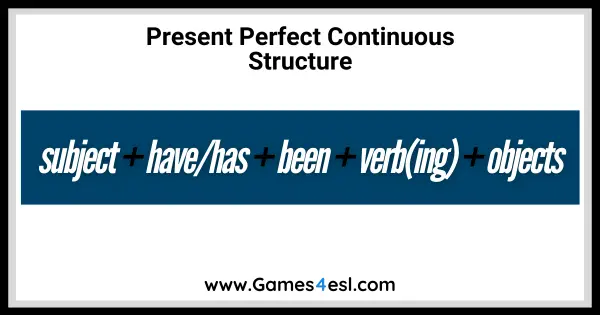How To Teach The Present Perfect Continuous | Step By Step
Once students have mastered the present perfect tense, learning the present perfect continuous tense is relatively easy. In fact, in many instances, either of these two tenses can be used. The main goal when teaching the present perfect continuous tense is to get learners to understand that it is used to emphasize how long a current activity has been going on for. In this guide, we will walk you through step by step how to teach the present perfect continuous.
How To Teach The Present Perfect Continuous Tense
Step 1: Review The Present Perfect
Any lesson on the present perfect continuous tense should begin with a review of the present perfect simple tense. Review the two main uses of the present perfect: to talk about finished past actions, and to talk about an action that started in the past and continued to the present. Elicit some example sentences from the students and write these on the board. If you want some tips on how to review this tense, check out our guide on how to teach the present perfect tense.
Step 2: Introduce The Present Perfect Continuous
Next, explain to students that the present perfect continuous tense is similar to the 2nd usage of the present perfect tense (to talk about an action that started in the past and continued to the present.). Explain that the present perfect continuous tense emphasizes the length of a current action and often describes an activity that will likely continue.
To help students understand, ask them how long they have been studying English and if they are still studying English. Point out that they will likely continue to study English in the future. Then write on the board “I have been studying English for 3 years.”. Next, elicit some more examples from students and write them on the board, also. For example, you can ask them how long they have been playing the piano, how long they have been listening to the teacher in the current lesson, etc.
Step 3: The Present Perfect Continuous Structure

Next, it’s time to show students the present perfect continuous structure. Write the following on the board:
subject + have/has + been + verb(ing) + objects
You may need to review with students what ‘subject’ and ‘object’ refers to and when to use ‘have’ vs ‘has’. A great way to do this is to look at the example sentences that you wrote on the board in step 2. For example, you can ask students to identify the subject in each sentence and then change the subject and ask students if they should change have/has to make a correct sentence.
Step 4: Present Perfect Continuous Activity
Now that students have an understanding of the present perfect continuous usage and structure, it’s time for students to make their own sentences. A super fun way to do this is with the following activity.
Put students into pairs or small groups. Tell them that they must draw a picture of a person doing something and write how long they have been doing the action using a present perfect continuous tense sentence. Once students have finished, have them share their pictures and sentences with the class.
This can lead to some really funny sentences. For example, one group might draw someone sleeping and write that “He has been sleeping for 5 days.“, or draw a person doing homework and write “She has been doing homework for 10 hours.“
Step 5: Present Perfect Continuous Exercise

Finally, it’s time to practice more with some present perfect continuous exercises. Download and print this worksheet and give one to each student. To complete the worksheet, students must fill in the blank to complete the present perfect continuous sentence. You can find more present perfect continuous exercises here.
Related
Thanks for reading. I hope you found this guide to teaching the present perfect continuous tense useful. For more teacher guides, check out these related posts:
How To Teach The Present Perfect
How To Teach The Present Simple
How To Teach The Passive Voice

